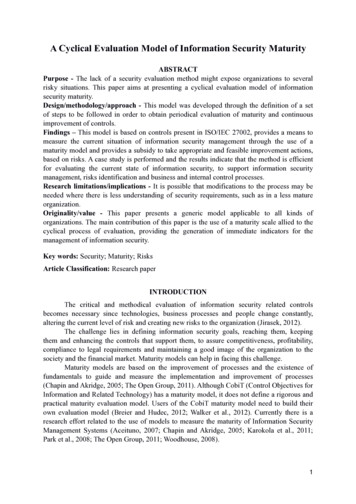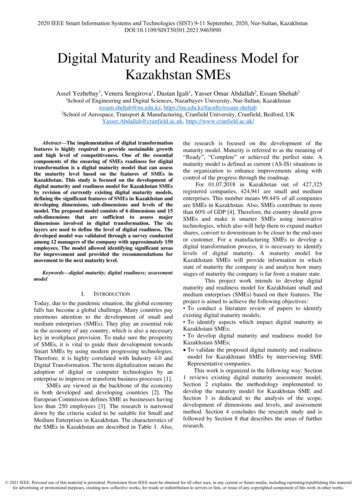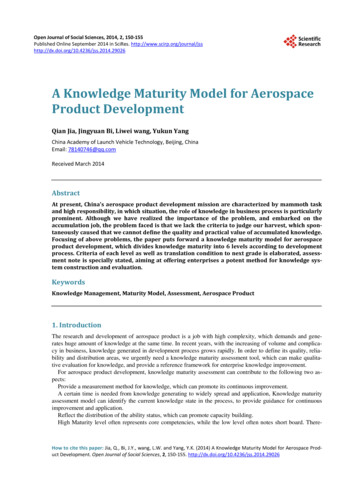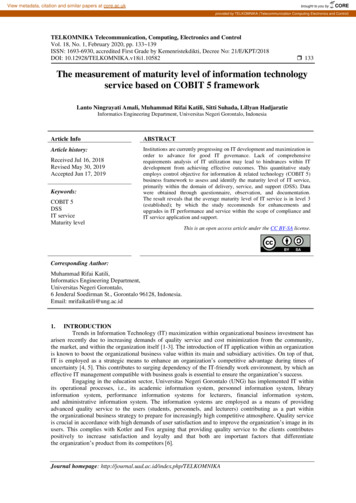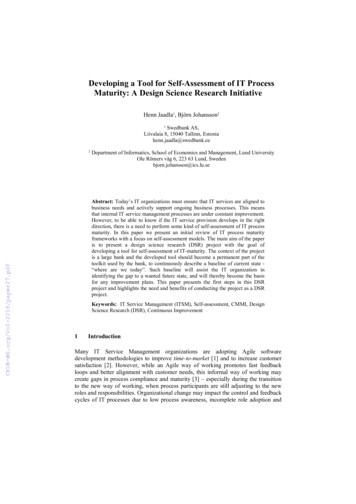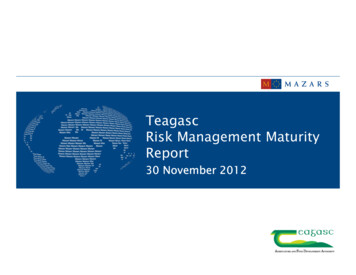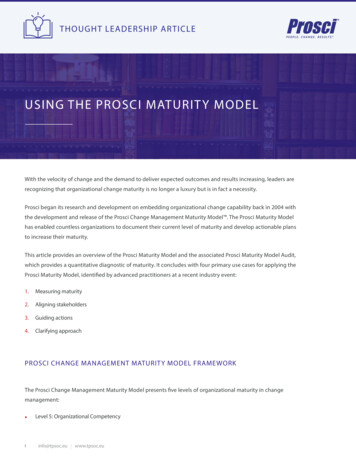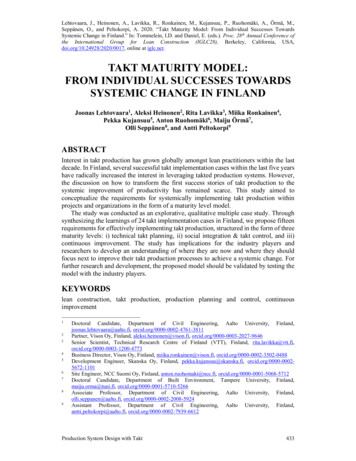
Transcription
Lehtovaara, J., Heinonen, A., Lavikka, R., Ronkainen, M., Kujansuu, P., Ruohomäki, A., Örmä, M.,Seppänen, O., and Peltokorpi, A. 2020. “Takt Maturity Model: From Individual Successes TowardsSystemic Change in Finland.” In: Tommelein, I.D. and Daniel, E. (eds.). Proc. 28th Annual Conference ofthe International Group for Lean Construction (IGLC28), Berkeley, California, USA,doi.org/10.24928/2020/0017, online at iglc.net.TAKT MATURITY MODEL:FROM INDIVIDUAL SUCCESSES TOWARDSSYSTEMIC CHANGE IN FINLANDJoonas Lehtovaara1, Aleksi Heinonen2, Rita Lavikka3, Miika Ronkainen4,Pekka Kujansuu5, Anton Ruohomäki6, Maiju Örmä7,Olli Seppänen8, and Antti Peltokorpi9ABSTRACTInterest in takt production has grown globally amongst lean practitioners within the lastdecade. In Finland, several successful takt implementation cases within the last five yearshave radically increased the interest in leveraging takted production systems. However,the discussion on how to transform the first success stories of takt production to thesystemic improvement of productivity has remained scarce. This study aimed toconceptualize the requirements for systemically implementing takt production withinprojects and organizations in the form of a maturity level model.The study was conducted as an explorative, qualitative multiple case study. Throughsynthesizing the learnings of 24 takt implementation cases in Finland, we propose fifteenrequirements for effectively implementing takt production, structured in the form of threematurity levels: i) technical takt planning, ii) social integration & takt control, and iii)continuous improvement. The study has implications for the industry players andresearchers to develop an understanding of where they are now and where they shouldfocus next to improve their takt production processes to achieve a systemic change. Forfurther research and development, the proposed model should be validated by testing themodel with the industry players.KEYWORDSlean construction, takt production, production planning and control, continuousimprovement123456789Doctoral Candidate, Department of Civil Engineering, Aalto University, Finland,joonas.lehtovaara@aalto.fi, orcid.org/0000-0002-4761-3811Partner, Vison Oy, Finland, aleksi.heinonen@vison.fi, orcid.org/0000-0003-2027-9646Senior Scientist, Technical Research Centre of Finland (VTT), Finland, usiness Director, Vison Oy, Finland, miika.ronkainen@vison.fi, orcid.org/0000-0002-3502-0488Development Engineer, Skanska Oy, Finland, pekka.kujansuu@skanska.fi, orcid.org/0000-00025672-1101Site Engineer, NCC Suomi Oy, Finland, anton.ruohomaki@ncc.fi, orcid.org/0000-0001-5068-5712Doctoral Candidate, Department of Built Environment, Tampere University, Finland,maiju.orma@tuni.fi, orcid.org/0000-0001-5710-5266Associate Professor, Department of Civil Engineering, Aalto University, Finland,olli.seppanen@aalto.fi, orcid.org/0000-0002-2008-5924Assistant Professor, Department of Civil Engineering, Aalto University, Finland,antti.peltokorpi@aalto.fi, orcid.org/0000-0002-7939-6612Production System Design with Takt433
Takt Maturity Model: From Individual Successes Towards Systemic Change in FinlandINTRODUCTIONTakt production has received a large amount of attention in the lean constructioncommunity within the last decade. Takt methods such as Takt Time Planning (TTP, e.g.,Frandson et al. 2013), Takt Planning and Takt Control (TPTC, e.g., Dlouhy et al. 2016)have demonstrated the potential of takted production to achieve more stable operationsand radically reduced production duration, among other benefits. Successfulimplementation cases have been reported in various locations – especially in the US(Frandson et al. 2013), Germany (Binninger et al. 2018), and Norway (Vatne andDrevland 2016) – and most recently, in Finland (Lehtovaara et al. 2019).Even though production systems leveraging takt have been occasionally utilized inFinland in the past, takt production has recently been considered as a basis for a systemicway (meaning that the changes affect the whole construction network) for improvingproduction systems. International benchmarking of the best production system practices,conducted in 2016 by Industry-University consortium consisting of 19 local industryplayers and a university research group (Lavikka et al. 2020), has been a central catalystfor increased interest towards takt production. Moreover, research and knowledge sharingwithin the consortium have reinforced the national interest in applying takt productioninto companies’ operations. The implementation results of radically decreased productionduration and positive testimonials (Lavikka et al. 2020) have received a large amount ofattention within the Finnish media, especially in Finland’s largest construction magazineRakennuslehti (e.g., Kivistö 2019, Mölsä 2020), further increasing the momentum withinthe industry.The shared results have inspired the top management of several companies, especiallythe general contractors and public clients, to adopt takt production as a key aspect of theirproduction development initiatives (Lavikka et al. 2020). In addition, designers, suppliers,and subcontractors have expressed their interest in implementing takt into their operations,as takt production has been perceived to increase their profitability and situationalawareness of the production as well (Lehtovaara et al. 2019). Between 2016-2020 taktproduction has been utilized in dozens of projects with varied scopes and primarilypositive testimonials. All in all, the resistance towards takt methods have rapidly declinedwithin the Finnish construction industry.However, to fully achieve the perceived benefits of takted production, a sharedunderstanding of how to move from individual case implementations into a systemic wayof implementing takt production is needed. Excluding a few pioneering clients andgeneral contractors, the industry players do not share an understanding on which elementstakt production consists of, while the academic discussion has mainly focused on how totechnically implement takt production in single projects. Missing shared understandingsets a barrier for systemic, regional change that would cumulatively and collectivelyincrease the benefits of takted production.Forming a maturity model offers a way to drive a shared understanding of systemictakt production implementation. In addition of enabling shared understanding of aphenomenon, maturity models are widely used by organizations to compare their positionin the competition, to identify focal points of development while offering a solid basis forimprovement and retaining competitive advantage in the market (de Bruin et al. 2005,Mettler 2011). Also, by conceptualizing different stages of development, maturity modelscan enable more systemic implementation and diffusion of innovations. Maturity modelshave also been driving development in construction, as they are, for example, widely used434Proceedings IGLC28, 6-12 July 2020, Berkeley, California, USA
Joonas Lehtovaara, Aleksi Heinonen, Rita Lavikka, Miika Ronkainen, Pekka Kujansuu,Anton Ruohomäki, Maiju Örmä, Olli Seppänen, and Antti Peltokorpito create a shared understanding in efforts to implement building information modeling(BIM) into projects and organizations (Liang et al. 2016).From this basis, this study aims to conceptualize the steps for systemicimplementation of takt production within projects and organizations in a regionalconstruction ecosystem by forming a takt maturity level model. The purpose of the modelis to provide takt implementers an understanding of where they are now and where theyshould focus next to develop their processes, to achieve the benefits of takt production inthe long term. The aim is pursued by answering a research question: What are therequirements for systemically implementing takt production within construction projectsand organizations?METHODOLOGYThe study was conducted as a multiple-case study that enabled to examine the phenomenaexploratively (Miles and Huberman 1994). Furthermore, the study took a grounded theoryapproach (Corbin and Strauss 1990) to allow the maturity model to emerge from theanalyzed data. We collected qualitative data from 24 Finnish takt productionimplementation cases from various different project types (Table 1) between 2016 and2020. Data collection was done through intensive observation of the cases, including theobservation of planning workshops, site meetings and site visits, productiondocumentation, and after-action reviews. While collecting data, we primarily focused onobserving the planning and execution of takt plan, the takt control process, collaboration,emerging barriers, and on how takt production affected on project success in overall.Table 1. The analyzed takt production implementation cases.CaseProject statusProject typeKey learning aspects in brief1FinishedCommercialEffective technical takt planning key aspect for success2FinishedCommercialEffective takt control with daily management key aspect for success3FinishedCommercialSubcontractor integration key aspect for implementing technical takt plan4FinishedCommercialSocial integration key aspect for success5FinishedIndustrialEffective takt planning key aspect for success6FinishedIndustrialEffective takt planning key aspect for success7FinishedInfrastructureEffective takt control with daily management key aspect for success8FinishedInfrastructureEffective takt control with social integration key aspect for success9FinishedResidentialEffective takt control with daily management key aspect for success10FinishedResidentialEffective takt control with daily management key aspect for success11FinishedResidentialEffective takt control, subcontractor integration key aspect for successEffective technical takt planning key aspect for success, opportunities in batch size lEffective takt planning, client integration key aspect for success14FinishedResidentialEffective takt control, subcontractor integration key aspect for success15FinishedResidentialEffective takt planning key aspect for success16FinishedResidentialEffective takt planning key aspect for success17FinishedResidentialSubcontractor integration key aspect for success18In progressCar ParkOpportunities in integrating subcontractors19In progressCommercialOpportunities in technical takt planning in general20In progressCommercialOpportunities in technical takt planning in general21In progressCommercialSubcontractor integration key aspect for success22In progressHospitalOpportunities in master plan integration23In progressHospitalOpportunities in takting critical phases24In progressInfrastructureOpportunities in batch size reduction to reduce lead timeProduction System Design with Takt435
Takt Maturity Model: From Individual Successes Towards Systemic Change in FinlandData analysis was conducted in collaboration with the authors by first mapping the mostprevalent lessons learned and clustering them into larger entities. These learnings werethen synthesized in the form of specific requirements, and further, structured into a formof maturity levels, forming cumulative requirements for systemically implementing taktproduction. After forming the maturity levels, we reflected on how the maturity levels aremet in current Finnish practices. In addition, we formed three short, illustrative caseexamples to concretize how different requirements of the maturity levels are met inpractice.PROPOSED MATURITY LEVELS FOR SYSTEMIC TAKTPRODUCTION IMPLEMENTATIONThe analysis revealed that in cases where project participants had little or no priorexperience with takt production, the key drivers for success were in forming a takt plan(Cases 1,5,6,12,13,15,16,19,20,22,23,24). In the cases where initial takt planning wasdone successfully, the bottlenecks for further development focused on the socialintegration of parties and effective takt control (Cases 2,3,4,7,8,9,10,11,14,17,18,21). Inaddition to these prevalent findings, it emerged from the data (at least partially from everycase) that continuous improvement over projects and over organizations was perceivedas a key element in reaping the benefits of takt production in the long term. Based onthese findings, the maturity levels were formed. The proposed three maturity levels and15 requirements to achieve them are presented in Table 2 below.Table 2: Takt maturity levelsLevel i)TECHNICAL TAKT PLANNING (project-level)R1The production plan fits the client’s requirementsR2Takt areas, takt time and wagons with resourcing are unambiguously determinedR3Effective visual management is ensuredLevel ii)SOCIAL INTEGRATION & TAKT CONTROL (project and organizational level)R4Training and involvement of the project participants is ensuredR5The logistics are integrated and takted with the production planR6The design process is integrated and takted with the production planR7The common situational awareness during production is ensuredR8Barriers are tackled through continuous and collaborative improvementR9Quality control is systematic and taktedLevel iii)CONTINUOUS IMPROVEMENT (organizational and regional level)R10Formulation and development of teamsR11Contractual integrationR12Systematic waste elimination over projectsR13Industrialized logistics and material flowR14Standardized, takt-based work quantity librariesR15Improving through KPI’s and data-driven decision makingLevel i) (technical takt planning) covers the requirements 1-3, which form a basis forgenerating a sound takt plan. Level ii) (social integration & takt control) covers therequirements from 4 to 9, including the involvement of supporting operations and trades436Proceedings IGLC28, 6-12 July 2020, Berkeley, California, USA
Joonas Lehtovaara, Aleksi Heinonen, Rita Lavikka, Miika Ronkainen, Pekka Kujansuu,Anton Ruohomäki, Maiju Örmä, Olli Seppänen, and Antti Peltokorpito the planning, as well as an effective takt control. Level iii) (continuous improvement)consists of features enabling the development over individual projects, while enablingconsistent productivity increase. At the moment, several Finnish companies that haveattempted to implement takt production in their operations, appear to be somewherebetween levels i) and ii), while also having weak signals on level iii) requirements. Leveli) requirements mainly concern projects, while level ii) requirements additionally call foractions on an organizational level. Furthermore, level iii) requirements require attentionon a regional level. It should also be emphasized that the requirements are cumulative, asthe further levels also require that the conditions on the lower levels are consistently met.TECHNICAL TAKT PLANNINGThe first level of maturity, technical takt planning, refers to the ability to formulate abalanced production plan that consists of takt time (the given time for a set of tasks to becompleted in a takt area), takt areas (areas in which the trades work during a given takttime), and takt wagons (set of tasks that are completed in a single takt time in a single taktarea). To form a theoretically sound takt plan, three requirements have to be met:R1. The production plan fits the client’s requirements (and is also realistic in thelight of the given constraints)The fundamental goal of takt production is to pace the production to match the client’sneeds. In addition, the resourcing, production time, space utilization, and material floware based on the constraints determined by available resources and given externalconstraints, forming a compromise between the most technically optimal and practicallyviable plan.R2. Takt areas, takt time and wagons with resourcing are balanced andunambiguously determinedProduction planning parameters are balanced to ensure a smooth flow of trades andprocesses, as they advance through the locations. The planning aims for optimal worksequence, minimal batch sizes, minimization of work-in-progress (WIP), optimal sizingand sequencing of areas, as well as feasible resourcing of trades (also brought up byDlouhy et al. 2016) In addition, every actor on the site, knows where, when, and whatthey should do for the whole duration of the production. The intervals for tracking theproduction progress are also determined.R3. Effective visual management is ensuredThe plan is visualized and available for every actor on the site, which also givesinformation regarding the tasks and locations of other actors in the given time, enablingcollaborative steering of production and tackling the emerging problems.Several project teams in Finland have quite rapidly acquired the knowledge to perform inthe maturity level one effectively. Solely forming and implementing a takt schedule(usually orchestrated by the GC) has shown excellent outcomes, resulting in 20-30%production duration reduction, especially when utilized in the interior phase. Similarresults have been demonstrated in other countries, too (e.g., Vatne and Drevland 2016).The benefit of implementing a technical takt plan surfaces from its ability to shake thetraditional way of production by bringing the problems visible that have been previouslyburied in overly long buffer times. The visibility has forced actors to look for solutionsfor improvement proactively, and especially to force actors to solve problems in theplanning phase that are usually issued encountered only during the production. AlthoughProduction System Design with Takt437
Takt Maturity Model: From Individual Successes Towards Systemic Change in Finlanddifficult at first, while also generating stress and unforeseen sense of urgency, the projectparticipants have generally admitted that the early handling of problems has reduced theamount of rework and quality defects, and enabled more paced and predictable productionwhich has made takt production implementation mostly a positive experience. Withsmaller batch sizes (smaller takt areas and shorter takt time), the previously mentionedeffects appear even more dramatically. Small batch sizes enable to find and solve theproblems more effectively and allowing better control of production. On the other hand,too small buffers in relation to a high amount of variation can disrupt the flow and makeproduction chaotic.Achieving the level one enables the opening of the ‘black box’ and allows the actorsto reduce variation proactively and to realize that they, indeed, have room forimprovement. In cases where the requirements of technical takt planning were met, it waswidely reported that to develop the process further, effective social integration and taktcontrol are necessary.Illustrative example case 1: Tackling the emerging issues proactively with technicaltakt planning in repetitive constructionIllustrative example case 1 is a residential building located in Helsinki, Finland, whichutilized takt production in its indoor phase, orchestrated by the general contractor. Thecase building consisted of 79 rental apartments, which floor plans vary from 28 to 40.5square meters, forming generally repetitive spaces. The indoor phase was originallyscheduled for nine months. The takt area was three apartments and the takt time one day.The tasks were divided into two production trains: 1) tasks located in the apartments(excluding bathrooms) and 2) tasks located in the bathrooms. In total, the first trainincluded 40 wagons and the second train 20 wagons.The takt control, however, did not fully proceed throughout the production accordingto one-piece flow principles. The flow was often interrupted, and the production sufferedfrom problems with materials such as delayed or too early deliveries, contradictingobjectives with the subcontractors, and lack of communication. Nevertheless, since thetakt planning was executed at such a detailed level, occurring issues and challenges weredetected in the early stages (requirements R1, R2). The detailed planning allowed the sitemanagement to react to problems before they cascaded to other wagons (R3).Even with challenges in takt control, the case resulted in apartments finishing withimproved quality, with more gained profit for the contractor and finish within the givenschedule. The finished apartments had only minor or no flaws, and the average time torepair the defects was 15–20 minutes per apartment, which was also reflected ondramatically reduced go-back work. Furthermore, the use of takt production reduced theduration of the interior phase from the originally scheduled nine months to eight months.The site personnel argued that an additional one month of time reduction would have beenpossible if it had been necessary. In addition, the general contractor was able to gain over40 percent more profits than initially targeted, mainly due to the decreased duration andbetter quality. In conclusion, the illustrative example case was able to achieve therequirements on maturity level i).SOCIAL INTEGRATION & TAKT CONTROLThe second level of maturity, social integration & takt control, refers to the ability tointegrate supporting operations and trades to the planning, with effectively controlling theproduction within takted pace. Takt control consists of tight production control operatedthrough daily production meetings (daily huddles), with a primary aim of achieving438Proceedings IGLC28, 6-12 July 2020, Berkeley, California, USA
Joonas Lehtovaara, Aleksi Heinonen, Rita Lavikka, Miika Ronkainen, Pekka Kujansuu,Anton Ruohomäki, Maiju Örmä, Olli Seppänen, and Antti Peltokorpisteady hand-offs between wagons at the end of every takt time (Frandson et al. 2013).The second level of readiness consists in total of six requirements:R4. Training and involvement of the project participants is ensuredProject participants, especially trade heads and workers, are trained to succeed with taktproduction. The participants are involved in the planning to utilize their expertise (alsomentioned by Tommelein 2017), and to engage them with the takt plan. The involvementrequires that the preliminary plan is formed before and continued in parallel withprocurement operations.R5. The logistics are integrated and takted with the production planMaterial deliveries to the site, storage and hauling of the material on the site are planned,buffered, and managed in a way that materials are available for every takt in time (alsosuggested by Lehtovaara et al. 2019).R6. The design process is integrated and takted with the production planThe designs are provided and checked beforehand for every takt in time. Theconstructability is ensured with the trades before given takt to achieve an uninterruptedinformation flow during the production.R7. The common situational awareness during production is ensuredSituational awareness (up-to-date information regarding the production status) is sharedamongst every actor on the site, enabling daily, visual, and collaborative management.The progress of the takt plan is checked in the pace of takt, and the plan is updated at theagreed intervals.R8. Barriers are tackled through continuous and collaborative improvementObstacles for work are reported and solved in collaboration, at a minimum, with the paceof takt. Actions for improvement, such as balancing resources or adding buffers, areagreed and conducted in agreement with the participants the actions affect.R9. Quality control is systematic and taktedQuality is controlled through systematic hand-offs between wagons in the pace of takttime. The control diminishes the need for rework and minimizes quality defects over timeas the initial defects are immediately fixed and prevented in the following takts.Even though several Finnish general contractors have formed their way of conductingtakt plans, the integration of other project participants and supporting activities to theproduction plan as well as effectively controlling the production are not well established.While creating a technical takt plan forms a prerequisite for successful production, it doesnot single-handedly guarantee success. As takt production is often seen solely as ascheduling process instead of a holistic way of planning and controlling production, GCled attempts often overlook the need to start takt planning in parallel with design andprocurement operations, while also opting for traditional firefighting over systemic andtakted production control.The need for social integration has been especially noted in more complex projects,such as hospital construction. For example, enabling the production flow between MEPand structural works is not easily achieved, if the knowledge of the trades, materialsuppliers, and designers is not utilized in the planning process. However, even in thesimplest production settings, it has been noted that the involvement and more thoroughtraining of project participants yields significantly better results. As long as theProduction System Design with Takt439
Takt Maturity Model: From Individual Successes Towards Systemic Change in Finlandconstruction process remains fragmented, holistic integration is essential for achievingthe full potential of takt production, as well as inspiring designers, suppliers, and tradesto be involved in development while also sharing the benefits of takt equally.Achieving level two enables the collaborative solving of the problems that thetechnical takt planning has brought into awareness, as well as exploiting the rhythm oftakt in production control. However, staying in level two only enables limitedimprovement over projects.Illustrative example case 2: Achieving stability and commitment with collaborativetakt planning and control in non-repetitive constructionThe second illustrative example case is a 40 000 square-meter, a multi-story officebuilding in Helsinki. The case used a 5-day takt partially for the interior phase of theproject. The takt production was implemented to MEP (Mechanical, Electrical andPlumbing) works for a single section of the building, which was determined as abottleneck for the whole project. The motive to utilize takt production was to decreaseproduction duration as well as to stabilize production to reduce the risks for cost andschedule overruns. To achieve the objectives, deeper collaboration between the generalcontractor and trades was perceived as a critical success factor (Figure 1).Figure 1: Takt production planning workshop with tradesThe process to formulate the takt plan was based on the six-step method by Frandson etal. (2013), while the planning was conducted in collaboration with the subcontractors (R4)during multiple workshops that also utilized collaborative pull-planning. The takt controlwas maintained with daily huddles and weekly contractor meetings. The atmosphere inthe daily huddles and contractor meetings was pleased due to well-organized production(R7, R8) even though the start of the takt production had some setbacks with takt areahandovers (partially missing R9). It was also noted that occasional unregular updating oftakt plan led to a lost situational awareness and partially reactive control of production,which additionally demonstrated the need for continuous control. Furthermore, inaddition to integrating subcontractors the process, integration of design management andlogistics could have yielded even better outcomes (missing R5, R6).Even though utilizing takt production did not reduce the production durationremarkably, collaborative planning and control of the critical section enabled more stable440Proceedings IGLC28, 6-12 July 2020, Berkeley, California, USA
Joonas Lehtovaara, Aleksi Heinonen, Rita Lavikka, Miika Ronkainen, Pekka Kujansuu,Anton Ruohomäki, Maiju Örmä, Olli Seppänen, and Antti Peltokorpiproduction and handover of the complex project, which was the second goal for taktproduction implementation. In addition to finishing the bottleneck tasks during the giventakts, effective takt control also enabled better steering of the related, non-takted taskswithin the section. It was perceived among the project participants that the collaborativetakt planning and control largely contributed to the success of the complex project. Inconclusion, illustrative example case 2 was able to achieve some of the requirements onmaturity level ii).CONTINUOUS IMPROVEMENTThe third level of maturity, continuous improvement, refers to the ability to collectivelylearn and develop the operations over individual projects and organizations. The thirdlevel of maturity consists in total of six requirements:R10. Formulation and development of teamsPartnerships over projects are formed that enable the development of consistent teams.Knowledge acquired from previous projects is transferred from the knowledge ofindividuals to knowledge of teams, and further for the following projects.R11. Contractual integrationContract models allow the integration of different parties to support the means of taktproduction, for example, by enabling the integration of key parties (such as contractors,designers) early on to the project, and by enabling the allocation of risks and benefitsadequately between project organizations.R12. Systematic waste elimination over projectsStandardized methods for root-cause analyses and systematic elimination of waste areenabled with collaboratively used tools such as A3 reports. The learnings aresystematically stored and further used in the following projects.R13. Industrialized logistics and material flowLocation-based bill of materials (BOM) is utilized to enable the tracking of materialconsumption and continuous waste elimination. Logistics, material, and wastemanagement are separated from value-adding work, by for example, utilizing a logisticsoperator that manager the material flow. (also suggested by Tetik et al. 2019)R14. Standardized, takt-based work quantity librariesThe performance of the teams is tracked and stored, forming a baseline to effectively formreliable takt plans in the following projects and enab
Forming a maturity model offers a way to drive a shared understanding of systemic takt production implementation. In addition of enabling shared understanding of a phenomenon, maturity models are widely used by organizations to compare their position in the competition, to identify focal points of development while offering a solid basis for


